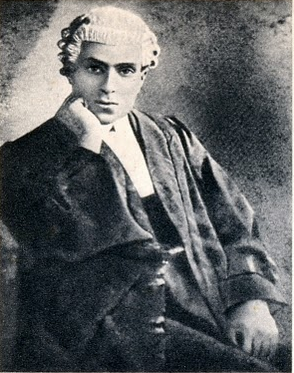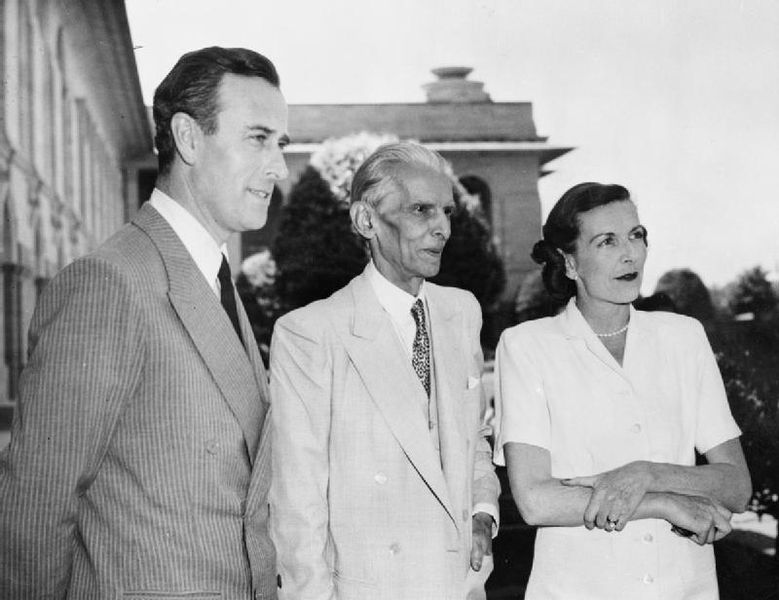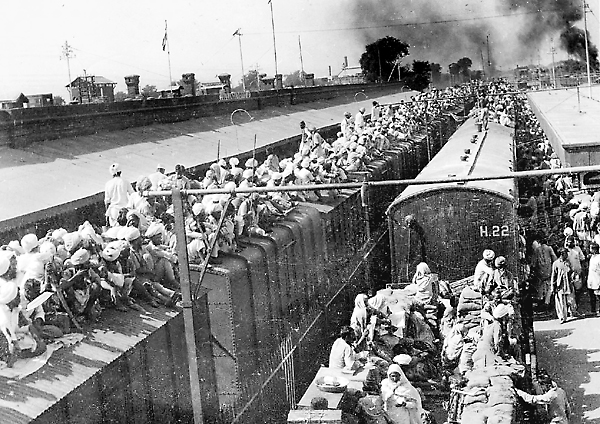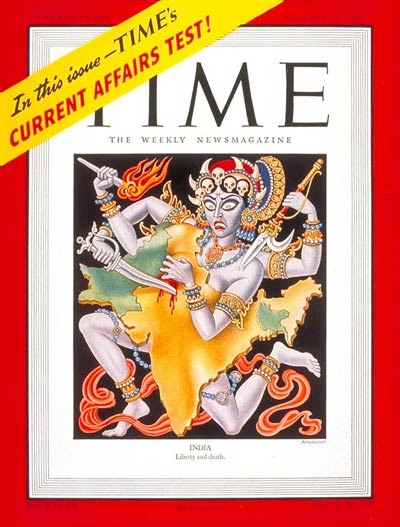How did an expatriate Indian lawyer who’d been living in South Africa for two decades become the leading figure in the movement for South Asian independence from British colonialism? Who were the other major figures in the push for Indian Independence? And when did the path toward the Partition of the subcontinent become the inevitable outcome? And what are the lingering effects on South Asian politics today?
Guest Aarti Bhalodia from UT’s South Asia Institute sheds light on one of the most pivotal, and traumatic, events of the 20th century.
Guests
 Aarti BhalodiaLecturer, Center for Asian-American Studies, The University of Texas at Austin
Aarti BhalodiaLecturer, Center for Asian-American Studies, The University of Texas at Austin
Hosts
 Christopher RosePostdoctoral Fellow, Institute for Historical Studies, The University of Texas at Austin
Christopher RosePostdoctoral Fellow, Institute for Historical Studies, The University of Texas at Austin
We’re going to be talking about the Indian Independence movement. Where should we begin our story?
We’re going to begin after the First World War because this is when Mahatma Gandhi–Mohandas Gandhi–comes back to India. He has been in South Africa for 21 years, and he’s back in India in 1919. This is when we see a different phase in Indian nationalism.
Where had he been–he’d been in South Africa, correct? What brought him to India?
Gandhi had been in South Africa because he was working as a lawyer for the South African Indian community. He had been active in movements to fight against discrimination of Indians in South Africa, for greater justice, and he comes back to India and starts becoming active in the ongoing nationalist movement. But what Gandhi did was that he took it to a different level, and he turns a movement that had been more constitutional and consisted mainly of lawyers and turned it into a mass movement and gets it out on the streets of India with a wider population being involved in the nationalist movement. And this starts after the First World War.

So, how did he do that? I’m thinking about the irony of a lawyer managing to turn what had been a legal struggle into something more populist. How was he able to accomplish that?
Gandhi did this by tapping into cultural symbols. He uses religious symbols. He makes sure that Congress, which was the nationalist body, did not restrict itself to using the English language, and he used the Indian vernacular languages to reach the non-Anglicized population of India, which is the majority. He makes use of these. He would have prayer meetings where people would come in. He made use of folk dances, songs, stories which your average Indian would be comfortable with, and he ties all of this into the nationalist movement and gives it a nationalist message in order to attract a broader appeal.
Since you mentioned that the nationalist movement did predate Gandhi, how did the other Indian nationalists–the ones who had already been agitating for independence–react to this guy who’s been in South Africa for 21 years suddenly showing up and starting his own movement?
At first the old guard were concerned with the direction in which Gandhi was taking the movement. They are not comfortable with mass movements, they are not comfortable with street protests. Some of them turn violent, and this was a cause for great concern. But, over time they begin to realize that Gandhi’s way might actually work out in the longer run because the constitutional methods they were using kept getting blocked out by the colonial state and did not lead to the results that they wanted. So, over time, they became willing to try a different approach. That’s where Gandhi becomes more and more prominent.
Also, he’s very popular among the Indian public. They see him as the Mahatma–the great leader–and you have these push and pull factors with the old leadership, allowing Gandhi to come in, as well as the Indian public welcoming him.
How did the British administrators react?
At the first, they have no idea what to make of Gandhi–he’s also starting his various experiments at this time, where he’s dressing in different clothes. He’s given up his suit and he’s no longer dressing as an Indian equivalent of the English gentleman, but he’s wearing Indian clothes and tries to dress himself as a farmer in clothes as simple as possible. The British have no idea how to understand this figure and his complete rejection of English culture. They also do not trust him when he says that he’ll keep his movements non violent, because a lot of them did becoming violent. It takes a while for the colonial state to figure out how to deal with Gandhi.
So, that was Gandhi. Who are the other major figures in the Indian nationalist movement?

There is Jawaharlal Nehru, who ends up becoming the first prime minister of India after independence in 1947, and Nehru is a generation younger than Gandhi but he, too, over time understands that Gandhi’s mass movement methods are going to become popular in India. He’s also active with the socialist wing of the nationalist movement. This is where he makes his own mark.
Another figure is Mohammad Ali Jinnah, who was also a lawyer from the same part of India that Gandhi came from, and is very popular among the Muslim population of India. Jinnah goes on to become the most important and most prominent leader of Indian Muslims when we get to the 1940s, and especially as we get closer to independence in 1947.
This is over the course of the 1930s that these various representatives are beginning to rise to prominence through the nationalist movement. How does World War II change things?
What happens in the second world war is that Indian nationalists, especially the Congress Party, which was one of the nationalist parties in the Indian Nationalist Congress–I should mention that Congress in India is a political party, it’s not a legislative body like Congress in the US (in India that’s the Parliament). The Congress Party decides that they do not want to support the British war effort during the second world war unless they get a guarantee of independence. They do not understand why they should be fighting this war as long as they’re a British colony. Congress decides to withdraw support.
The colonial state has no tolerance for any of Congress’s opposition, so all the main leaders are rounded up and put in jail. So now, Congress is a party without any key leadership.
But there’s another political party called the Muslim League, in which Mohammad Ali Jinnah, whom I just mentioned, is becoming more and more popular. And they make the decision to work with the British during this time period as a way to increase their following among the Indian public. The Muslim League had a difficult time in the 30s when Congress was becoming more and more popular, and the League was having a hard time getting votes in the provincial elections, which were first held in 1937. So, the League uses the Second World War as a time to increase its popularity.
The League and Congress both were facing difficulties in the thirties because the Muslim League wanted greater representation for Muslims, while Congress was not interested in having any special provisions for any minorities. The League, their main concern was that Muslims were going to be a permanent minority in India. During British colonial rule, Muslims make up about 20%–one fifth–of the population. They’re going to be a permanent minority. And their concern is how they’re going to be affected by the installment of a representative form of government, which is what they’re likely to have as an independent country. So, they’re asking for greater provisions, and Congress is not going to give it to them. And this is where we see the main competition and conflict between the League and Congress, which carries us through the 1930s and 1940s.
So, the League was able to try to gain some favor with the British administrators by supporting them during the war? Is that what they were going for?
Yes, that is what they were going for. And, especially since Congress decided to withdraw all support from the colonial state, and they were put in jail, what the British needed was people to work with during the time of the war. And the Muslim league and other smaller political parties were willing to be the allies.

So, when was the idea of Partition in India into–for lack of better terms–a “Hindu homeland” and a “Muslim homeland,” when was that first floated?
The question of a separate homeland for Hindus and Muslims, this idea was floating around in the 40s, but the interesting thing is that we have no idea what the boundaries are going to be. Because nobody is talking about set boundaries, some are saying that the two provinces of Punjab–which is today partitioned between India and Pakistan–and Bengal–which is partitioned between India and Bangladesh–that they would not be partitioned and they would separately be part of a different state. Another proposal is that you do not need two different states, you need two different nations. There would be a Hindu nation and a Muslim nation, and both of them would have a common military, common communication system, common foreign affairs–so there would be a federated state of two nations.
People were coming up with many different ideas, and using that as a bargaining tool when they came to the roundtable with the colonial state. So, we do not have any set boundaries until the very end when the actual partition takes place.

At what point does Partition become the inevitable outcome of independence?
This would be after the second world war is over, and everything is done, and the Labour government comes to power in Britain and they decide that they want to leave India as quickly as possible. They appoint a new viceroy in 1947–this was Lord Mountbatten–and Mountbatten comes to the conclusion, quickly, that he will not be able to come up with any sort of solution which will satisfy both the Congress party and the Muslim League. He decides to come up with the Partition proposal. This is in February 1947.
By August 1947, within a few months, Partition is already done. And that is when we have independence as well as partition both at the same time.
Can we take a moment to explain where the name “Pakistan” comes from?
The name Pakistan is first proposed by a group of students at Cambridge. These were a group of South Asian Muslim students, who decided that this separate nation or state or whatever was going to come about should have a name. And it’s an acronym: P stands for Punjab, A is the Afghan people–this would be the North West Frontier Province; the K comes from Kashmir, which is today quite a problematic region between India and Pakistan; the S stands for Sind, which is where the capital of Pakistan, Karachi, is located; the ISTAN part comes from Baluchistan, which is west of Sind on the Iranian border.
Conveniently, the word “Pakistan” also means “land of the pure.” So, they get to bring in all these various ethnic groups and regions and come up with a name which means “land of the pure.”
Now, I can’t help but notice that what’s not included in that name is Bengal, which was originally part of Pakistan…
Yes! So, you’re already seeing the 1971 conflict which is still many years off. What happens with Bengal is that it also has a large Muslim population, and these other provinces we just talked about also have a large Muslim majority, and so the idea is that perhaps these Muslim majority provinces should be part of a separate nation, perhaps even a separate state.
But, our students at Cambridge are only seeing this one region of South Asia, which would be come Pakistan, and they’re ignoring their Bengali speaking brothers and sisters because they’re so remote. These are two regions which do not have that common a culture, the languages are different. They share a religion, yes, but there are so many other differences that they’re not even thinking about them when they come up with this acronym of Pakistan.
Going back to Partition, there were also a number of princely states that were basically forced to pick which country they would join, correct?
That is correct, yes. I would say that, before Partition, about 1/3 of the region were under these Princely Territories, which were under the control of Indian kings, or, in some cases, queens. These were not under direct control of the British empire, they were usually under indirect rule. For the Princely States, nobody really pays any attention to them. All of the dialog is happening with the Congress Party and the Muslim League, and with the Hindu/Muslim question, and now what is going to happen to the Princely States? Are they going to get independence too? Or are they going to merge with their neighboring British Indian provinces, which would later become India and Pakistan once Partition has been decided upon?
What the Congress wants is that these princely states should merge with their neighboring provinces because they want India to be a republic, and they do not want to have any kings or queens. They definitely do not want the English crown, and they also do not want any within India. They push for the merging of all of the princely states. Now, the majority of the princes were forced to sign on the dotted line, so to speak, and it was Congress as well as the last viceroy, Mountbatten, who sat them down and explained what was going to happen. The kings and princes understood that once the British withdrew their support, they had no way to defend themselves. A lot of these territories were really small – it could range from a few towns, to some of the bigger ones such as Kashmir and Hyderabad, which were the size of a lot of European countries. It took a long time to convince some of the bigger states to join India or Pakistan, but by 1948 all the princely states had merged with one of the successor states.
August of 1947: Independence Day. As I understand, it was India one day and Pakistan the next–or I might have those reversed–what happens?
They picked midnight of August 14-15, and this date was actually picked after they consulted astrologers. It was an auspicious day, and the next auspicious day wasn’t coming for many weeks, and the British wanted to leave as quickly as possible. So, they’ve picked the 14th-15th. Pakistan gained independence on the 14th, India on the 15th, and the actual transfer of power was at midnight. Mountbatten first attended the transfer of power ceremonies for Pakistan, and then he flew over to Delhi and did so for India, and this was all in a 24 hour period.
Correct me if I’m wrong: Mountbatten remained on as–was he Governor-General?–of India for a while?
Yes, he did remain on. Nehru, who became the first Prime Minister of India, asked Mountbatten to stay on as Governor-General. Nehru’s goal was that negotiations with the princely states could continue more smoothly. Remember: Mountbatten was the cousin to the queen as well as the king, so he is an aristocrat himself, and Indian princes preferred negotiating with a fellow aristocrat. Also, to smooth over relations with Pakistan: once the british quit India, they somehow become this neutral party. They always had their own agenda, but they became a neutral party that could negotiate with all of these different political powers involved.

Partition is famously known for the tragic human effect that it had on the population. Could you talk a little bit about what spurred on what is, I believe, one of the biggest mass migrations in human history?
The language used, especially by ’47, is that there needs to be a separate state which would be a homeland for Muslims, because Pakistan would be where Muslims could be safe and they could lead the type of lives that they want. This language gets repeated again and again. India by default becomes a Hindu state, even though Congress kept talking about how it was going to be a secular country. So, what happens after official partition is there is this mass migration of over 12 million people. These are Muslims who are moving toward what is going to become Pakistan, and Hindus–and a group that is often forgotten: Sikhs–moving toward what is going to become India. Now, the Sikhs picture in this because the province of Punjab was a heavily Sikh province, and they decide to move towards India. You had Sikhs living in Lahore, in what became Pakistan, and they crossed over the newly formed border, and go to India. So, mainly Hindus, Muslims, and Sikhs combined, we’ve got twelve and a half million people–and these are people who are forever leaving their homes, their villages, often with nothing more than the clothes on their back. People are going over by foot, along with their animals, they’re going by trains, and this is one of the biggest migrations in human history.
What was the fallout of the traumatic birth of these two countries–and later, three, if we include Bangladesh? Are we still seeing the legacy of this tumultuous start in south Asian politics?
Partition definitely lives on in the memory of the people of South Asia, because the birth of the two nations. One one level, you have a very smooth transfer of power with the elite political leaders, but the situation on the ground is very different. You have people basically forced to go to a different country. There is anger, there is grief, often this was accompanied by violence. This trauma of partition lives on in all the three countries once you include Bangladesh, and you have very good oral histories that have been compiled in recent years by talking to survivors of Partition and how they had to begin their lives anew in a different city where they did not know anyone, and they had to start fresh at an advanced age in their lives.
Documents and Further Reading
Works by Mohandas K. Gandhi in the South Asian American Digital Archive
Through My Eyes > Partition of India
Imperial War Museum – Online Exhibition (including images, video and interviews with refugees from the Partition of India).
A People Partitioned
Five radio programs broadcast on the BBC World Service in 1997 containing the voices of people across South Asia who lived through Partition.
India: The Internet History Sourcebooks Project
Archive of public-domain documents about Indian history from ancient to modern periods, including Independence and Partition.